
Evaluate Window Functions for the Discrete Fourier Transform
The Discrete Fourier Transform (DFT) operates on a finite length time sequence to compute its spectrum. For a continuous signal like a sinewave, you need to capture a segment of the signal in order to perform the DFT. Usually, you also need to apply a window function to the captured signal before taking the DFT [1 - 3]. There are many different window functions and each produces a different approximation of the spectrum. In this post, we’ll present Matlab code that plots the spectra of windowed sinewaves for any window function, and computes figures of merit for the window function.
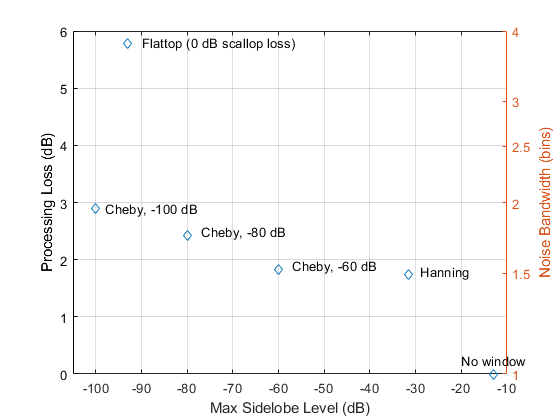
Background
The DFT is good at finding the spectrum of finite-duration signals, but a snag arises for signals that are continuously present over long duration, for example, a sinewave. The snag is apparent in the DFT formula, which is defined over a finite number of samples N:
$$X(k)=\sum_{n=0}^{N-1}x(n)e^{-j2\pi kn/N} $$
Where
X(k) = discrete frequency spectrum of time sequence x(n)
n = time index
k = frequency index
N = number of samples of x(n) and X(k)
So, by its definition, the DFT does not apply to infinite duration signals.
Figure one is an example of a finite-duration signal – it is fully captured in less than 256 time samples. On the other hand, the sinewave at the top of Figure 2 has an infinite number of samples. If we try, as in the bottom of Figure 2, to capture a chunk of it and take the DFT, there is no reason to expect a happy result. The mismatch in amplitude between the two ends of the signal distorts the spectrum, a phenomenon called spectral leakage. We would have to capture an exact integer number of periods to get an accurate spectrum.
The way around this problem is illustrated in Figure 3. In this example, we capture 128 samples of the sinewave, then multiply each sample by the corresponding sample of the window function shown in the middle plot, which has the property of smoothly approaching zero at each end. The result is the “windowed” sinewave at the bottom, which is now a finite-duration signal. This more or less works, but as we’ll see, the spectrum is that of the captured signal convolved with the spectrum of the window. Next, we’ll look at the spectrum of a window and then apply the window to a sinewave.
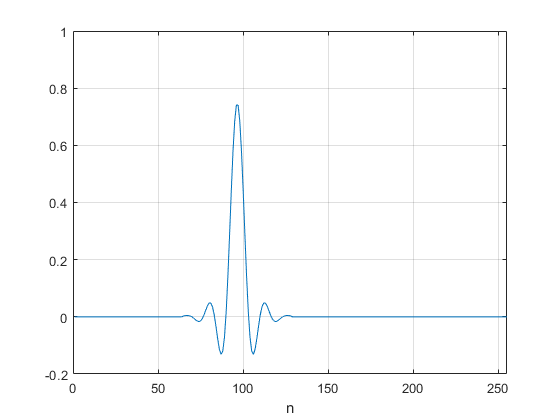
Figure 1. Signal of finite duration
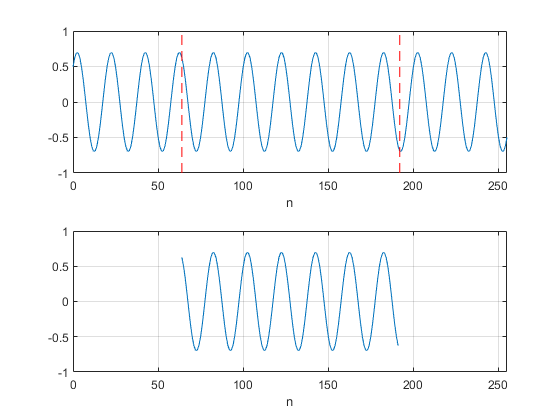
Figure 2. Top: Signal of infinite duration. Bottom: 128-point capture of signal.
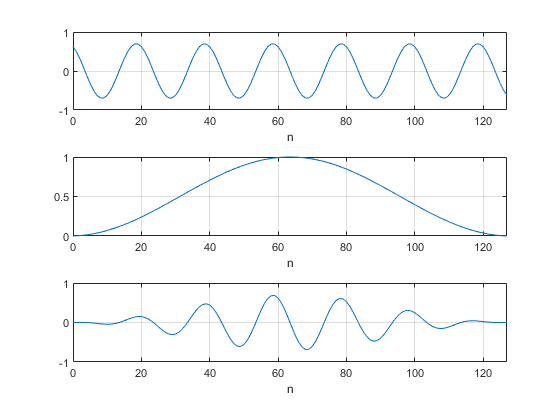
Figure 3. Top: Captured sinewave
Middle: Window function
Bottom: Windowed sinewave
Spectrum of the Hanning Window
One commonly used window, the Hann, or Hanning window, is defined by
this formula [4]:
$$w(n)=0.5(1-cos(2\pi n/N)), \quad n=0:N-1$$
As an example, for N = 8, we have: w = [0 0.1464 0.5 0.8536 1 0.8536 0.5 0.1464]. We can create an N= 32 Hanning window as follows:
N= 32; % number of time samples
win= hanning(N,'periodic'); % hanning window
The window is plotted at the top of figure 4. Now we’ll look at the spectrum of the window. We can approximate the Fourier Transform of the window by appending zeros to the window (zero-padding) and taking the DFT. If we zero-pad such that the number of samples is increased by a factor of L, then the DFT frequency spacing is reduced by a factor of L compared to the N-point DFT [5]. For large enough L, all the important detail of the Fourier Transform is displayed by the DFT. The Matlab fft function fft(x,NFFT) automatically appends zeros to x to length NFFT. Here is the code to find the spectrum of the hanning window:
win= win/sum(win); % scale window for |h(0)| = 1
% NFFT-point FFT of N-point window function
fs= 16; % Hz sample frequency
L= 32;
NFFT= L*N;
k= 0:NFFT/2-1; % freq index for NFFT-point FFT
f= k*fs/NFFT; % Hz frequency vector
h = fft(win,NFFT); % FFT of length NFFT (zero padded)
h= h(1:NFFT/2); % retain points from 0 to fs/2
HdB= 20*log10(abs(h)); % dB magnitude of fft
The dB-magnitude spectrum is plotted in the bottom plot of Figure 4.
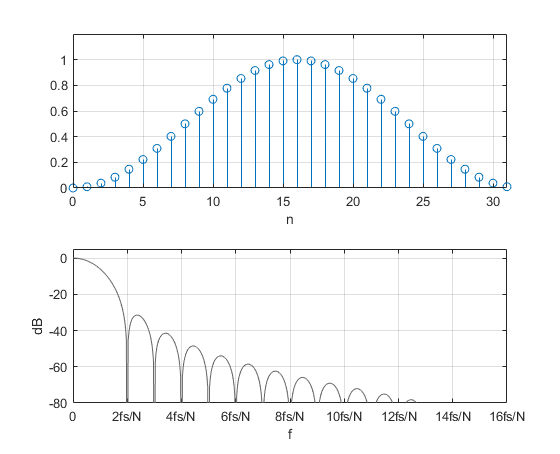
Figure 4. Top: Hanning window, N= 32
Bottom: Spectrum of Hanning window for FFT length = N*32
Windowing a Sinewave
Now we’ll look at the spectrum of windowed sinewaves. It will behoove us to keep careful track of the power of the signal and its spectrum.
First, we define the window, then scale it such that the power of the window function is 1 watt (refer to my earlier post on the power spectrum [6]).
fs= 16; % Hz sample frequency
N= 32; % number of time samples
win= hanning(N,'periodic'); % hanning window
win= win.*sqrt(N/sum(win.^2)); % normalize window for P = 1 W
Now define the sinewave. In this example, we let the sine frequency f0 = 4*fs/N = 4*16/32= 2 Hz. This sinewave has exactly 4 of periods over N, and f0 falls exactly on a DFT frequency sample – i.e. the center of a DFT bin.
A= sqrt(2); % sine amplitude for P= 1 W
Ts= 1/fs;
n= 0:N-1; % s time index
f0 = 4*fs/N; % Hz f0= 2 Hz
x= A*sin(2*pi*f0*n*Ts); % sine at bin center, P= 1 watt
Next apply the window and find the DFT by using the Matlab fft function. The Matlab operator .* indicates element-by-element multiplication, or dot product. The prime on win’ creates a row vector from the column vector win. We compute both the N*L-point and N-point DFT, and scale to obtain power into a one-ohm load.
xw= x.*win'; % apply window to sinewave
X= fft(xw,NFFT); % FFT of length NFFT (zero padded)
X= X(1:NFFT/2); % retain points from 0 to fs/2
P= 2/N.^2 * abs(X).^2; % power spectrum into 1 ohm
PdB= 10*log10(P); % dB magnitude of zero-padded FFT
PdB_dec= PdB(1:L:NFFT/2); % dB magnitude of non zero-padded FFT
The N-point and N*L-point DFT’s are plotted in the top of Figure 5. Each spectrum is just that of the Hanning window in Figure 4 convolved with that of a sinewave at 2 Hz (multiplication in the time domain is equivalent to convolution in the frequency domain). Unlike the ideal sine spectrum, the windowed spectrum has a finite bandwidth and sidelobes. The -40 dB bandwidth of the main lobe is about 4fs/N = 4*16/32 = 2 Hz. The bandwidth is inversely proportional to the number of samples N of the captured sinewave.
For an unwindowed sine at bin center, we expect the spectral peak to be 0 dB (1 watt into 1 ohm). But the peak of the spectrum using the Hanning window is -1.74 dB because the power is spread over several samples instead of all being contained in one sample. If power of a narrowband spectral component is important, this reduction of the peak level, called processing loss, should be taken into account.
Processing loss is proportional to the bandwidth of the window. In fact, it is exactly equal to the noise bandwidth (in bins) of the window (see appendix B). As a practical matter, higher processing loss/noise bandwidth makes it harder to discern a low-level signal in the presence of noise (it gets hidden by the noise floor) and degrades the ability to resolve signals that are closely-spaced in frequency.
Now let f0 = 4.5 fs/N. This sinewave has 4.5 periods over N, and f0 falls exactly between DFT frequency samples – i.e. the edge of a DFT bin.
f0 = 4.5*fs/N; % Hz f0= 2.5 Hz
x= A*sin(2*pi*f0*n*Ts); % sine at bin edge, P= 1 watt
If we window this sinewave and find the DFT’s as above, we get the spectra plotted in the bottom of Figure 5. The N*L-point DFT has the same shape as the spectrum at bin center. However, the N-point DFT has a different peak value and higher skirts. The difference in peak value is about 1.44 dB for the Hanning window. So here is another source of error in the displayed spectrum. This variation in the DFT amplitude is called scalloping loss [7]. Note that scalloping is only an issue for narrowband signals that have bandwidth less than the frequency bin of the DFT.
To summarize, here is a list of properties of a sinewave’s windowed spectrum:
- There is a main lobe with bandwidth proportional to 1/N.
- There are typically sidelobes with finite attenuation.
- For a sine at bin center, processing loss is the level of the spectral peak relative to that of an unwindowed sine.
- The noise bandwidth in bins is equal to the processing loss (Appendix B).
- Depending on the window used, scalloping loss occurs when the sine frequency is not at the center of a bin.
The 3-dB or 6-dB bandwidth of the main lobe is sometimes called resolution bandwidth. The sidelobe level with respect to the main lobe peak level is sometimes called dynamic range. Dynamic range is a measure of the ability to discern a small signal in the presence of a larger signal. Note that for the Hanning window, the sidelobes of the N-point DFT’s (blue curves of Figure 5) are not visible as distinct features.
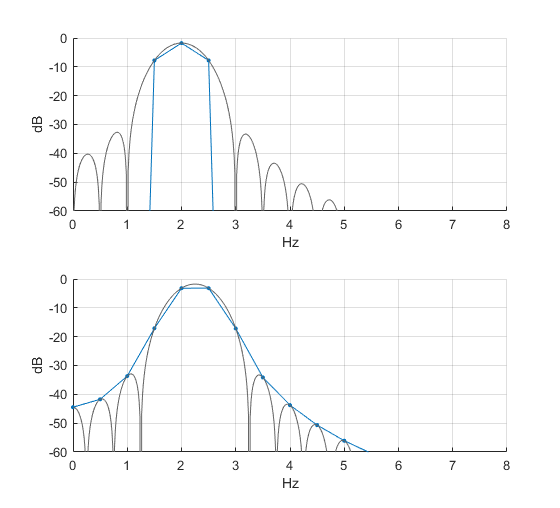
Figure 5. Top: Spectrum of Windowed Sine with f0 = 4*fs/N = 2 Hz (center of bin)
Bottom: Spectrum of Windowed Sine with f0 = 4.5*fs/N = 2.5 Hz (edge of bin)
A Matlab Function to Evaluate Windows
The Matlab function win_plot(win,fs) is listed in Appendix A. This function computes several window figures of merit, and plots the windowed N-point DFT of two sine waves located at f0= fs/8 (center of a bin) and f1= fs/4 + .5fs/N (edge of a bin), where N is the length of the window win. The inputs to the function are a window vector win and sample frequency fs (Hz). The length of win must be a power of 2.
If fs is set equal to length(win), then frequency is equal to bin number and the x-axis units are indicated as “bins”.
Here is an example using the Hanning window of length 256 and fs= 200 Hz. The function outputs the figures of merit shown and plots the DFT spectrum.
win= hanning(256,'periodic');
win_plot(win,200)
noise bw (bins) 1.4942
proc loss (dB) 1.744
max proc loss (dB) 3.1789
scallop loss (dB) 1.435
As shown in Figure 6, The output spectrum is plotted twice, with two different amplitude scales. The top plot has a 10 dB range and the bottom plot has a 120 dB range. The lower frequency sine at a bin center shows the processing loss of 1.74 dB. The upper frequency sine at a bin edge shows the max processing loss of 3.18 dB. Scallop loss is the difference of these two values.
If we want the x-axis units in bins, we set fs = length(win) = 256:
win= hanning(256,'periodic');
win_plot(win,256)
The resulting plot is shown in Figure 7, which is identical to figure 6, except that the x axis is in bins instead of Hz. Like the blue curves in Figure 5, the sidelobes are not individually visible for this N-point FFT. The spectrum of the sinewave located at a bin edge is about -50 dB at 5 bins from the center.
In summary, the Hanning window has low processing loss/noise bandwidth, but only modest dynamic range.
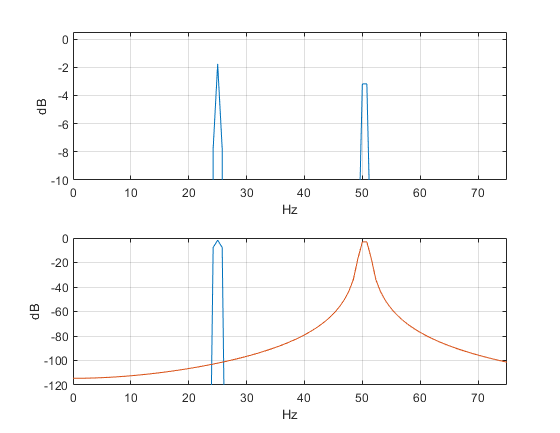
Figure 6. Output spectra of win_plot(win,200) for win = hanning(256,'periodic')
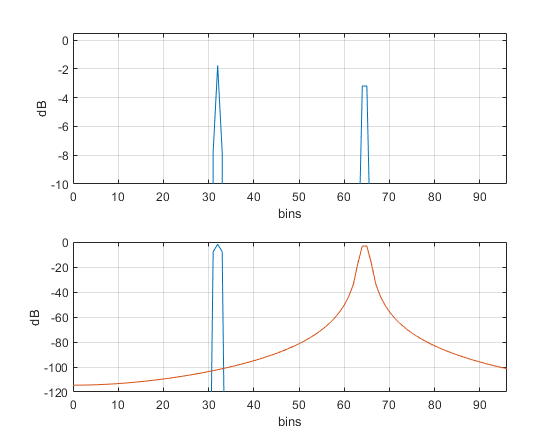
Figure 7. Output spectra of win_plot(win,256) for win = hanning(256,'periodic')
fs = 256 = length(win), causing x-axis units to be bins
Processing loss = 1.74 dB; noise bw = 1.5 bins; scallop loss = 1.44 dB
Window Examples using win_plot
Now let’s look at a few more windows. See Table 1 for a comparison of their figures of merit.
1. No Window
win= rectwin(256);
win_plot(win,256);
Having no window is equivalent to a window that is all ones – the rectangular (boxcar) window of Figure 8. Figure 9 shows the spectrum. Processing loss is ideal at 0 dB, but spectral leakage is massive for the sinewave at the edge of a bin.

Figure 8.Rectangular or boxcar window, N= 256
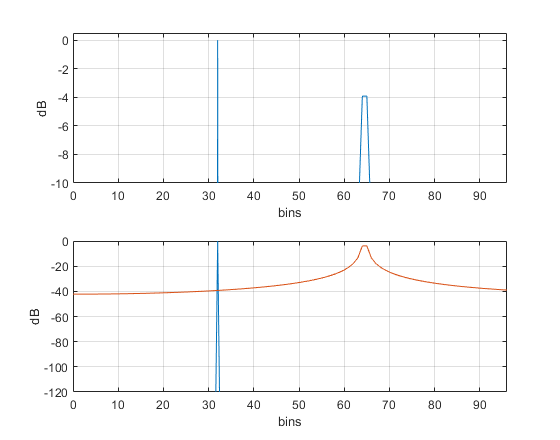
Figure 9. Output spectra of win_plot(win,256) for win = rectwin(256)
Processing loss = 0 dB; noise bw = 1 bin; scallop loss = 3.9 dB
2. A window with no scalloping loss – flattop window
win= flattopwin(256,'periodic');
win_plot(win,256);
The flattop window (Figure 10) has 0 dB scalloping loss, which allows you to display the amplitude of a narrowband signal accurately, even if it falls at a bin edge. It also has good dynamic range. However, the processing loss/noise bandwidth are high (Figure 11). The formula for the flattop window of length N is [8]:
$$w(n)=a_0-a_1cos\left(\frac{2\pi n}{N-1}\right) + a_2cos\left(\frac{4\pi n}{N-1}\right) -a_3cos\left(\frac{6\pi n}{N-1}\right) +a_4cos\left(\frac{8\pi n}{N-1}\right), \quad n=0:N-1$$
where
a0 = 0.21557895
a1= 0.41663158
a2= 0.277263158
a3= .083578947
a4= .006947368
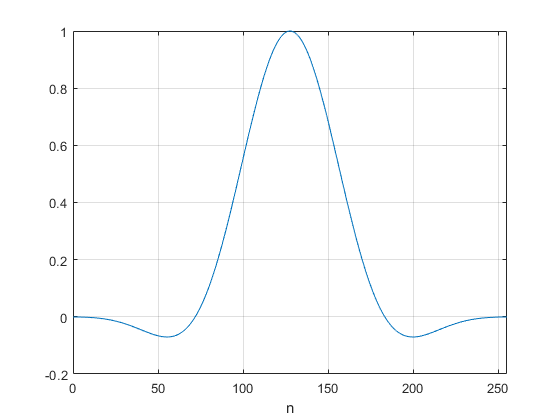
Figure 10. Flattop Window, N= 256
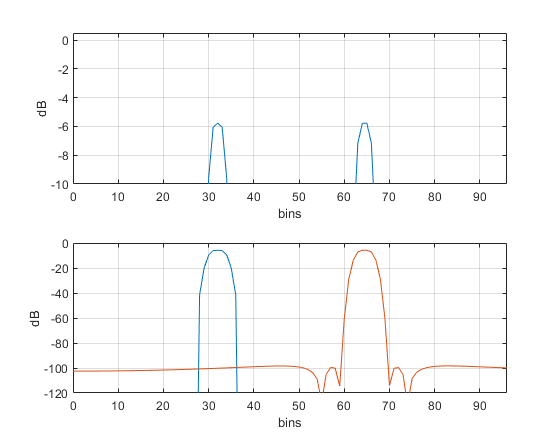
Figure 11. Output spectra of win_plot(win,256) for win = flattopwin(256,'periodic')
processing loss = 5.78 dB; noise bw = 3.8 bins; scallop loss = 0 dB
3. A window with adjustable sidelobe level – Chebyshev Window
win= chebwin(256,80); % window with -80 dB sidelobes
win_plot(win,256);
The Chebyshev window has flat (equiripple) sidelobes that can be adjusted to any level. It allows you to trade bandwidth vs. sidelobe level. Figure 12 shows the window for -80 dB sidelobes. The spectra are shown in Figure 13. Calculating the window function is somewhat involved; see [9,10].

Figure 12. -80 dB Chebyshev Window, N= 256
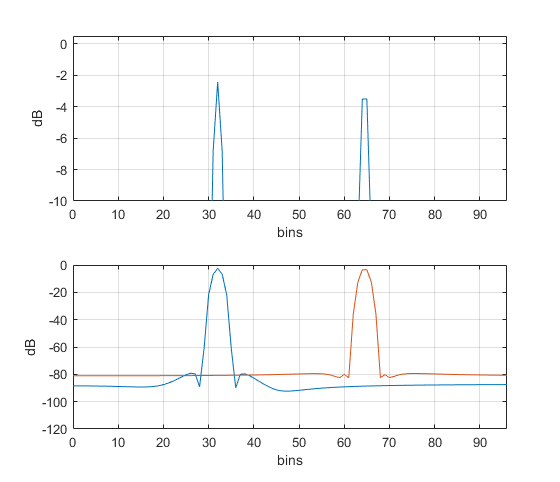
Figure 13. Output spectra of win_plot(win,256) for win = chebwin(256,80)
Processing loss = 2.42 dB; noise bw = 1.75 bins; scallop loss = 1.08 dB
Table 1 lists figures of merit for various windows. Figure 14 compares several window functions by plotting processing loss/noise bandwidth vs. maximum sidelobe level. Performance increases as you move towards the lower left corner.
Table 1.Windows Figures of Merit
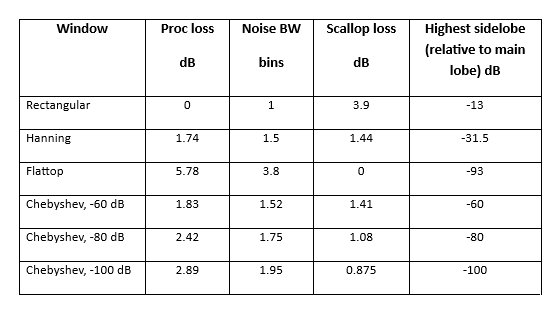

Figure 14. Processing Loss/Noise Bandwidth vs. Maximum Sidelobe Level for various window functions.
Appendix A Matlab Function win_plot
Calculation of the power of the DFT spectrum was discussed in an earlier post [6].
% win_plot(win,fs).m 12/13/18 Neil Robertson
%
% Evaluate window functions using sine at center of bin
% and sine at edge of bin.
%
% win window vector, length must be a power of 2.
% fs sample frequency in Hz
%
% ex:
% win= hanning(256);
% win_plot(win,200);
%
% Note: if fs = N = length(win), display x-axis units as "bins"
%
function win_plot(win,fs)
A= sqrt(2); % sine amplitude for P= 1 W
Ts= 1/fs; % s sample time
N= length(win);
s= size(win);
if s(2)== 1
win= win'; % if win is a column vector, take transpose
end
xunit= 'Hz'; % units of plot x-axis
if fs== N
xunit= 'bins';
disp('fs = N: x-axis units are bins')
disp(' ')
end
win= win.*sqrt(N/sum(win.^2)); % normalize window for P = 1
n= 0:N-1;
f0= fs/8; % center of bin
f1= fs/4 + .5*fs/N; % edge of bin
x1= A*sin(2*pi*f0*n*Ts); % sine at center of a bin, P = 1 watt
x2= A*sin(2*pi*f1*n*Ts); % sine at edge of a bin, P = 1 watt
% FFT of sine at bin center x1
xw= x1.*win; % apply window
X= fft(xw,N);
X= X(1:N/2); % retain samples from 0 to fs/2
P= 2/N.^2 * abs(X).^2; % W/bin power spectrum into 1 ohm
Pmax= max(P); % W/bin max of power spectrum
PdB1= 10*log10(P);
noise_bw_bins= 1/Pmax; % bins noise bandwidth of window
proc_loss_dB= -max(PdB1); % dB process loss of window
% FFT of sine at bin edge x2
xw= x2.*win;
X= fft(xw,N);
X= X(1:N/2);
P= 2/N.^2 * abs(X).^2;
PdB2= 10*log10(P);
max_proc_loss_dB= -max(PdB2); % dB max process loss of window
scallop_loss_dB= max_proc_loss_dB - proc_loss_dB; % dB scallop loss
% outputs
disp(['noise bw (bins)',num2str(noise_bw_bins)])
disp(['proc loss (dB)',num2str(proc_loss_dB)])
disp(['max proc loss (dB)',num2str(max_proc_loss_dB)])
disp(['scallop loss (dB)',num2str(scallop_loss_dB)])
k= 0:N/2-1; % frequency index
f= k*fs/N; % Hz frequency
subplot(211),plot(f,PdB1,f,PdB2,'color',[0 .447 .741]),grid
axis([0 3*fs/8 -10 .5])
xlabel(xunit),ylabel('dB')
subplot(212),plot(f,PdB1,f,PdB2),grid
axis([0 3*fs/8 -120 0])
xlabel(xunit),ylabel('dB')
subplot(111)
.
Appendix B Noise Bandwidth
Suppose gaussian noise of density N0 W/bin is applied to a lowpass or bandpass filter with response H(k). Let the output noise power of the filter be Pnoise. Now, consider an ideal lowpass or bandpass filter whose output noise power for the same gaussian noise input is also Pnoise. We define the noise bandwidth of H(k) as the bandwidth of this ideal filter [11]. We also require that the maximum values of |H(k)| and the ideal filter response be the same.
Figure B.1 shows a response H(k) that happens to be that of a sinewave windowed by a flattop window (blue curve). Also shown is an ideal filter that defines the noise bandwidth of this response. Let P(k) be the noise power per bin into 1 ohm at the output of H(k) [6]:
$$P(k)= \frac{2}{N^2}N_0|H(k)|^2 \quad W/bin \qquad (B.1)$$
Then, from the above definition of noise bandwidth,
$$N_0*|H_{max}|^2*noise \,bandwidth=N_0* \frac{2}{N^2}\sum_{k=0}^{N/2-1}|H(k)|^2 \qquad (B.2)$$
Where
N0 = Input noise density, W/bin
|Hmax|= maximum value of |H(k)| (dimensionless)
Noise bandwidth = bins
N = number of samples in two-sided response
Noise bandwidth is then
$$ noise \,bandwidth= \frac{1}{|H_{max}|^2}\frac{2}{N^2}\sum_{k=0}^{N/2-1}|H(k)|^2 \quad bins \qquad (B.3)$$
For a normalized window function [6], the numerator term is
1, and we have simply
$$noise \,bandwidth \quad(bins)=\frac{1}{|H_{max}|^2} \qquad (B.4) $$
For a windowed sinewave, |Hmax|2 is just 1/processing loss. (For a normalized window function, |Hmax|2 < 1). For example, processing loss of the Flattop window spectrum of Figure B.1 is 5.781 dB. This is a magnitude of 10^(5.781/10) = 3.78. Thus, noise bandwidth is 3.78 bins.
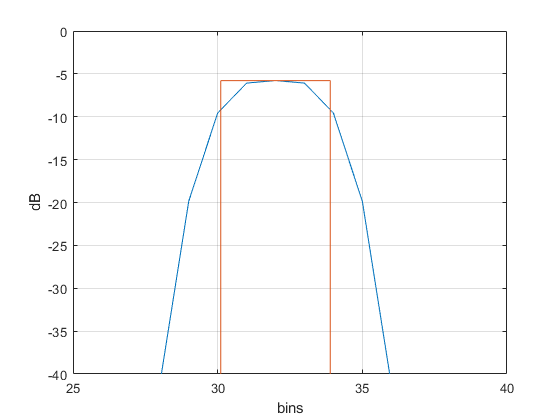
Figure B.1 A frequency response (blue curve) and the ideal response defining its noise bandwidth.
.
References
- Lyons, Richard, “Widowing Functions Improve FFT Results”, EDN, June 1, 1998. https://www.edn.com/electronics-news/4383713/Windowing-Functions-Improve-FFT-Results-Part-I
- Rapuano, Sergio, and Harris, Fred J., An Introduction to FFT and Time Domain Windows, IEEE Instrumentation and Measurement Magazine, December, 2007. https://ieeexplore.ieee.org/document/4428580
- Harris, Fredric J., “On the Use of Windows for Harmonic Analysis with the Discrete Fourier Transform”, Proc. IEEE, vol 66, pp. 51-83, Jan 1978. https://www.utdallas.edu/~cpb021000/EE%204361/Great%20DSP%20Papers/Harris%20on%20Windows.pdf
- Lyons, Richard, Understanding Digital Signal Processing , Third Ed., Prentice Hall, 2011, p 91.
- Lyons, section 3.11.
- Robertson, Neil, “The Power Spectrum” https://www.dsprelated.com/showarticle/1004.php
- Lyons, section 3.10
- Mathworks website https://www.mathworks.com/help/signal/ref/flattopwin.html
- Lyons, Richard, “Computing Chebyshev Window Sequences” https://www.dsprelated.com/showarticle/42.php
- Wikipedia https://en.wikipedia.org/wiki/Window_function#Dolph%E2%80%93Chebyshev_window
- Harris, Op. cit.
Neil Robertson December, 2018 Revised 2/22/20, 11/20/21, 3/23/23

- Comments
- Write a Comment Select to add a comment
Hi Robertson,
Thank you for your sharing. I really like these articles that trace the fundamentals.
I have a question about "% scale window for |h(0)| = 1".
What is the purpose?
BR,
TW

Hi,
The purpose is to have the frequency response h(k) of the window function have a magnitude of 1 at zero Hz. I probably should have used different notation. If I use the notation h(n) for a time function and H(k) for its DFT, the formula for the DFT of h(n) is:
H(k)= sum[h(n)*exp(-j*2*pi*k*n)/N)]
The value of H at k = 0 is then simply:
H(0) = sum[h(n)]
So, given some h(n), if you let h_norm(n) = h(n)/sum[h(n)], then
sum[hnorm(n)] = 1 and Hnorm(0) = 1.
regards,
Neil
P.S. There are two different types of normalization. This response normalization is not the same as the power normalization discussed in my earlier post (reference 6).
I am a bit confused about equation B.2. The units on the left and right side of the equation are W^2/bin, what is the physical meaning of this?
Further, if I have N0 to pass through a filter H, then the output noise power is N0*noisebandwidth?
BR,
TW

TW,
Thanks for finding this error. To correct the error, everywhere the term Pmax occurs, replace it with |Hmax|^2, where |Hmax| is the maximum value of |H(k)|.
|Hmax| is dimensionless. I'll update the post to correct the error soon.
regards,
Neil
To post reply to a comment, click on the 'reply' button attached to each comment. To post a new comment (not a reply to a comment) check out the 'Write a Comment' tab at the top of the comments.
Please login (on the right) if you already have an account on this platform.
Otherwise, please use this form to register (free) an join one of the largest online community for Electrical/Embedded/DSP/FPGA/ML engineers:
























